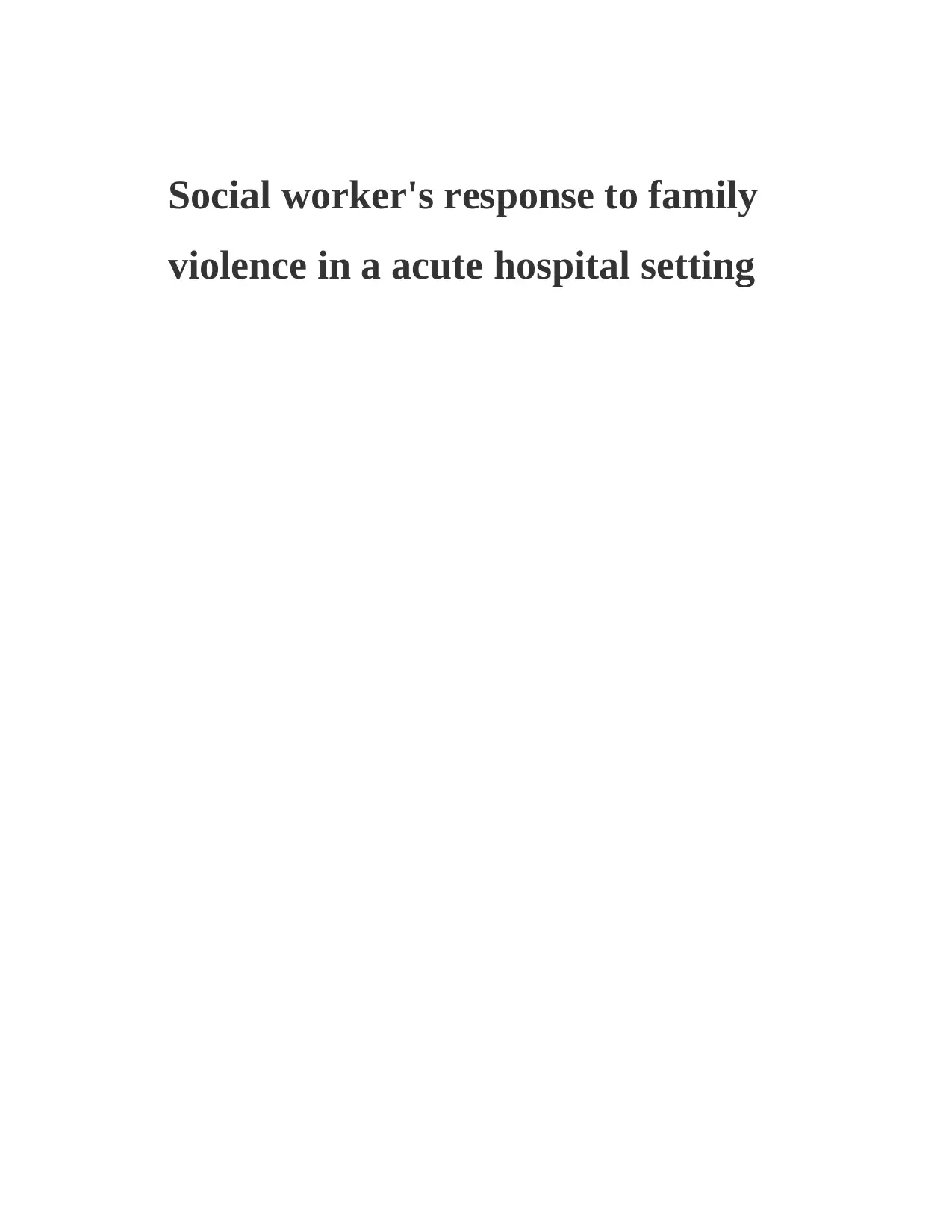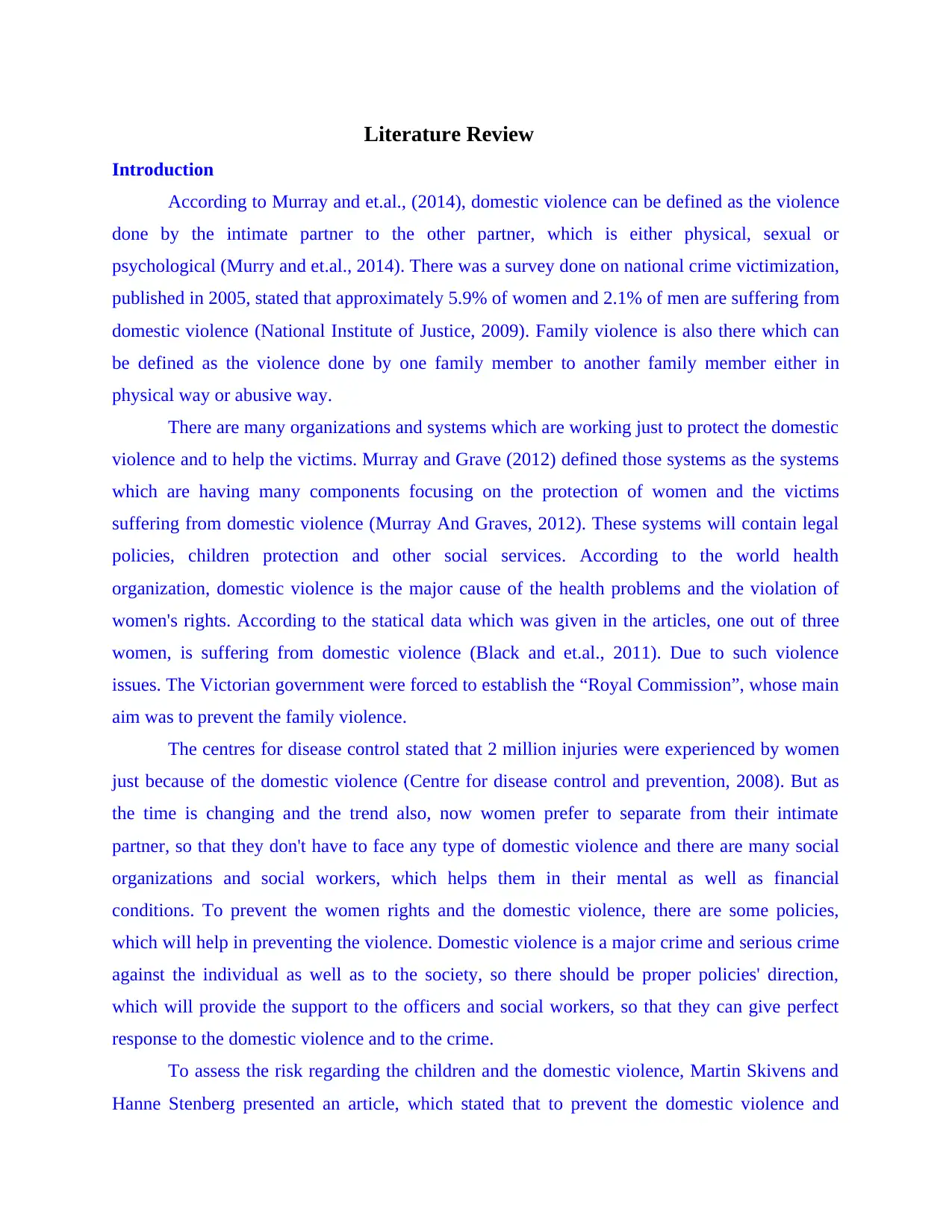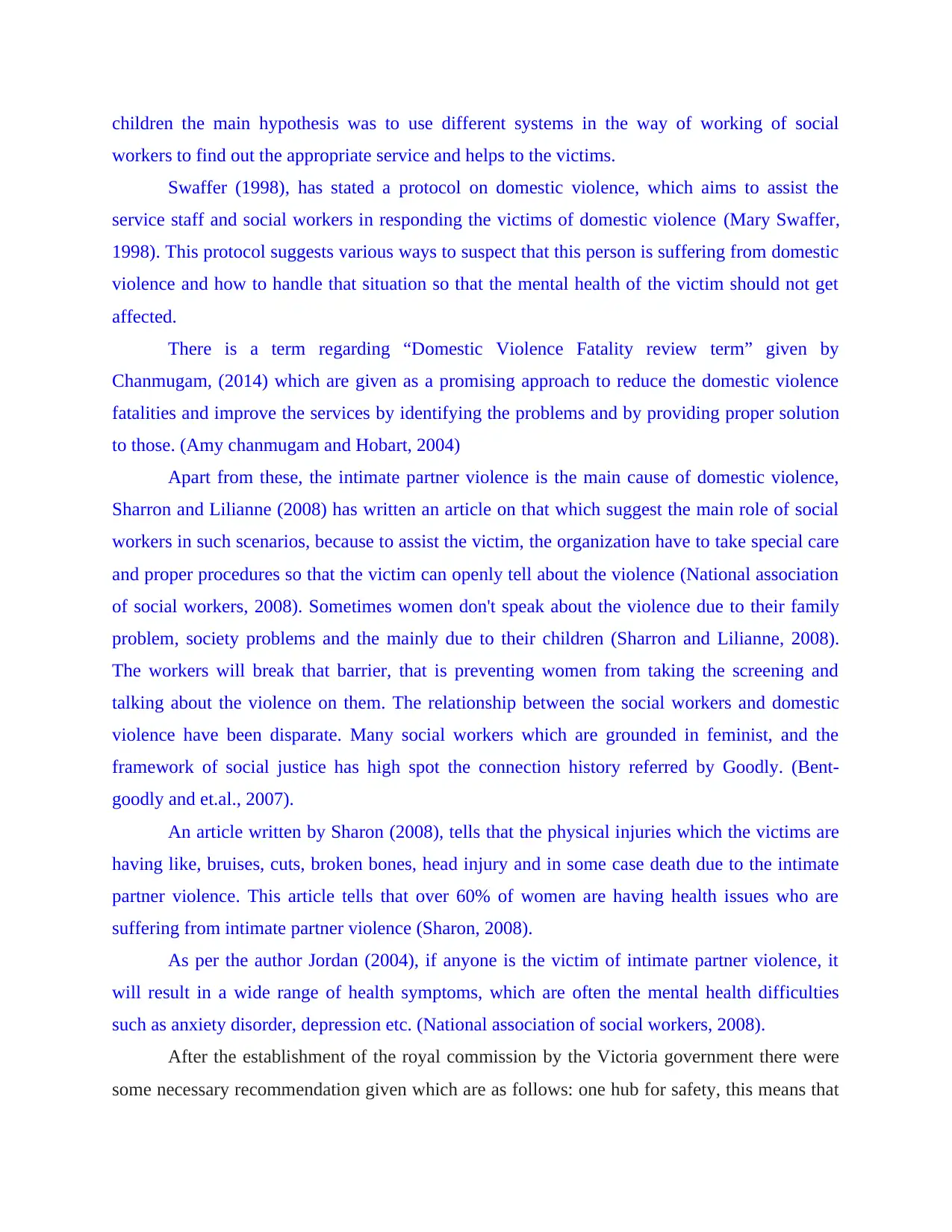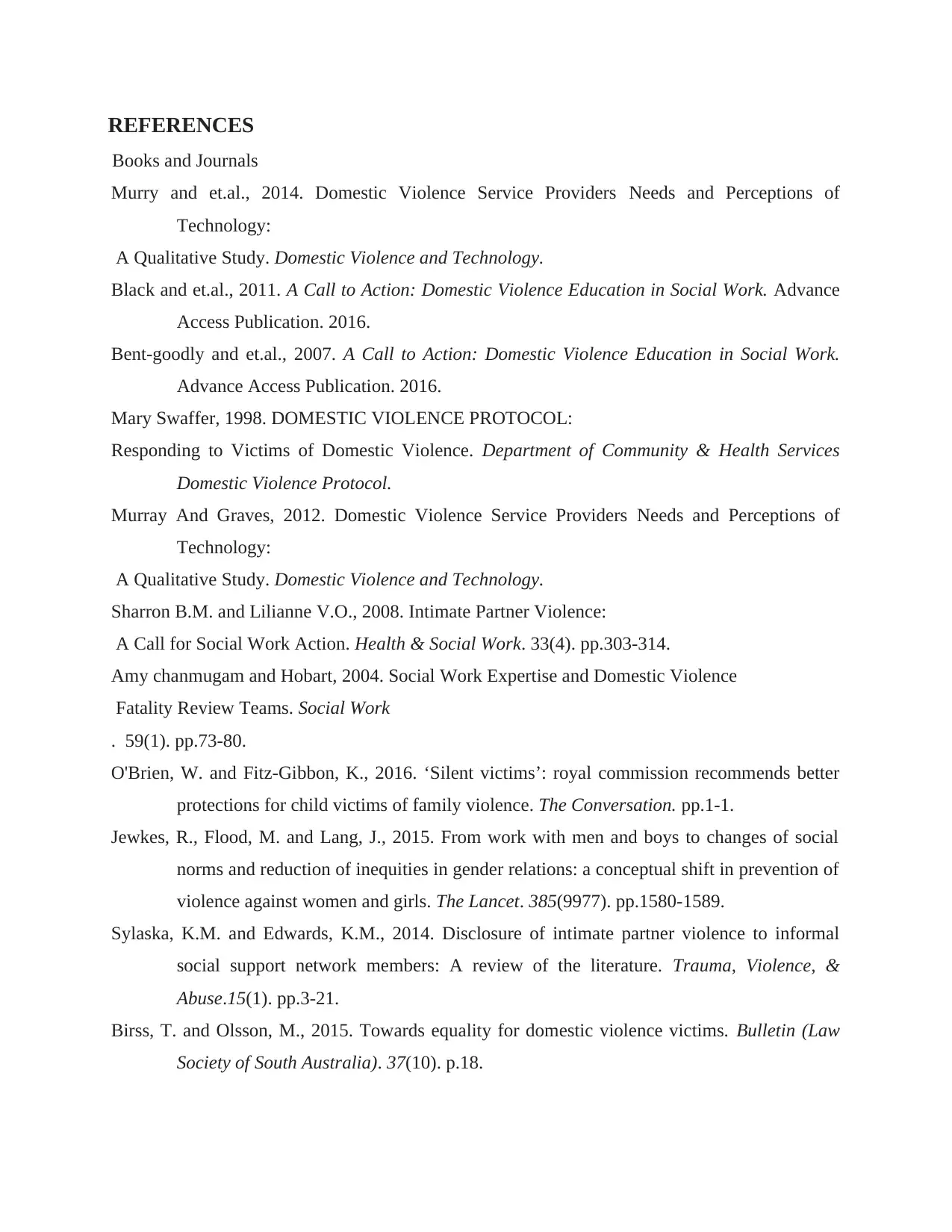Social Worker's Response to Family Violence in Acute Hospital Settings
VerifiedAdded on 2020/01/23
|8
|1766
|51
Literature Review
AI Summary
This literature review explores the critical role of social workers in addressing family violence within acute hospital settings. It defines domestic violence and family violence, citing statistics and the impact on victims, including both physical and mental health issues. The review highlights the evolution of responses, including the establishment of commissions and the development of protocols to assist social workers in identifying and supporting victims. It examines the importance of social worker training, the need for specialized services, and the implementation of policies to protect victims and children. The review references key studies and articles, covering topics such as intimate partner violence, health symptoms, and the recommendations of the Royal Commission on family violence, including the establishment of safety hubs, crisis services, and violence courts. The conclusion emphasizes the progress made in addressing family violence, with an increased awareness, improved support systems, and stricter regulations. The review offers a thorough overview of the subject, providing insights into the challenges and progress in the field of social work and family violence.

Social worker's response to family
violence in a acute hospital setting
violence in a acute hospital setting
Paraphrase This Document
Need a fresh take? Get an instant paraphrase of this document with our AI Paraphraser

Literature Review
Introduction
According to Murray and et.al., (2014), domestic violence can be defined as the violence
done by the intimate partner to the other partner, which is either physical, sexual or
psychological (Murry and et.al., 2014). There was a survey done on national crime victimization,
published in 2005, stated that approximately 5.9% of women and 2.1% of men are suffering from
domestic violence (National Institute of Justice, 2009). Family violence is also there which can
be defined as the violence done by one family member to another family member either in
physical way or abusive way.
There are many organizations and systems which are working just to protect the domestic
violence and to help the victims. Murray and Grave (2012) defined those systems as the systems
which are having many components focusing on the protection of women and the victims
suffering from domestic violence (Murray And Graves, 2012). These systems will contain legal
policies, children protection and other social services. According to the world health
organization, domestic violence is the major cause of the health problems and the violation of
women's rights. According to the statical data which was given in the articles, one out of three
women, is suffering from domestic violence (Black and et.al., 2011). Due to such violence
issues. The Victorian government were forced to establish the “Royal Commission”, whose main
aim was to prevent the family violence.
The centres for disease control stated that 2 million injuries were experienced by women
just because of the domestic violence (Centre for disease control and prevention, 2008). But as
the time is changing and the trend also, now women prefer to separate from their intimate
partner, so that they don't have to face any type of domestic violence and there are many social
organizations and social workers, which helps them in their mental as well as financial
conditions. To prevent the women rights and the domestic violence, there are some policies,
which will help in preventing the violence. Domestic violence is a major crime and serious crime
against the individual as well as to the society, so there should be proper policies' direction,
which will provide the support to the officers and social workers, so that they can give perfect
response to the domestic violence and to the crime.
To assess the risk regarding the children and the domestic violence, Martin Skivens and
Hanne Stenberg presented an article, which stated that to prevent the domestic violence and
Introduction
According to Murray and et.al., (2014), domestic violence can be defined as the violence
done by the intimate partner to the other partner, which is either physical, sexual or
psychological (Murry and et.al., 2014). There was a survey done on national crime victimization,
published in 2005, stated that approximately 5.9% of women and 2.1% of men are suffering from
domestic violence (National Institute of Justice, 2009). Family violence is also there which can
be defined as the violence done by one family member to another family member either in
physical way or abusive way.
There are many organizations and systems which are working just to protect the domestic
violence and to help the victims. Murray and Grave (2012) defined those systems as the systems
which are having many components focusing on the protection of women and the victims
suffering from domestic violence (Murray And Graves, 2012). These systems will contain legal
policies, children protection and other social services. According to the world health
organization, domestic violence is the major cause of the health problems and the violation of
women's rights. According to the statical data which was given in the articles, one out of three
women, is suffering from domestic violence (Black and et.al., 2011). Due to such violence
issues. The Victorian government were forced to establish the “Royal Commission”, whose main
aim was to prevent the family violence.
The centres for disease control stated that 2 million injuries were experienced by women
just because of the domestic violence (Centre for disease control and prevention, 2008). But as
the time is changing and the trend also, now women prefer to separate from their intimate
partner, so that they don't have to face any type of domestic violence and there are many social
organizations and social workers, which helps them in their mental as well as financial
conditions. To prevent the women rights and the domestic violence, there are some policies,
which will help in preventing the violence. Domestic violence is a major crime and serious crime
against the individual as well as to the society, so there should be proper policies' direction,
which will provide the support to the officers and social workers, so that they can give perfect
response to the domestic violence and to the crime.
To assess the risk regarding the children and the domestic violence, Martin Skivens and
Hanne Stenberg presented an article, which stated that to prevent the domestic violence and

children the main hypothesis was to use different systems in the way of working of social
workers to find out the appropriate service and helps to the victims.
Swaffer (1998), has stated a protocol on domestic violence, which aims to assist the
service staff and social workers in responding the victims of domestic violence (Mary Swaffer,
1998). This protocol suggests various ways to suspect that this person is suffering from domestic
violence and how to handle that situation so that the mental health of the victim should not get
affected.
There is a term regarding “Domestic Violence Fatality review term” given by
Chanmugam, (2014) which are given as a promising approach to reduce the domestic violence
fatalities and improve the services by identifying the problems and by providing proper solution
to those. (Amy chanmugam and Hobart, 2004)
Apart from these, the intimate partner violence is the main cause of domestic violence,
Sharron and Lilianne (2008) has written an article on that which suggest the main role of social
workers in such scenarios, because to assist the victim, the organization have to take special care
and proper procedures so that the victim can openly tell about the violence (National association
of social workers, 2008). Sometimes women don't speak about the violence due to their family
problem, society problems and the mainly due to their children (Sharron and Lilianne, 2008).
The workers will break that barrier, that is preventing women from taking the screening and
talking about the violence on them. The relationship between the social workers and domestic
violence have been disparate. Many social workers which are grounded in feminist, and the
framework of social justice has high spot the connection history referred by Goodly. (Bent-
goodly and et.al., 2007).
An article written by Sharon (2008), tells that the physical injuries which the victims are
having like, bruises, cuts, broken bones, head injury and in some case death due to the intimate
partner violence. This article tells that over 60% of women are having health issues who are
suffering from intimate partner violence (Sharon, 2008).
As per the author Jordan (2004), if anyone is the victim of intimate partner violence, it
will result in a wide range of health symptoms, which are often the mental health difficulties
such as anxiety disorder, depression etc. (National association of social workers, 2008).
After the establishment of the royal commission by the Victoria government there were
some necessary recommendation given which are as follows: one hub for safety, this means that
workers to find out the appropriate service and helps to the victims.
Swaffer (1998), has stated a protocol on domestic violence, which aims to assist the
service staff and social workers in responding the victims of domestic violence (Mary Swaffer,
1998). This protocol suggests various ways to suspect that this person is suffering from domestic
violence and how to handle that situation so that the mental health of the victim should not get
affected.
There is a term regarding “Domestic Violence Fatality review term” given by
Chanmugam, (2014) which are given as a promising approach to reduce the domestic violence
fatalities and improve the services by identifying the problems and by providing proper solution
to those. (Amy chanmugam and Hobart, 2004)
Apart from these, the intimate partner violence is the main cause of domestic violence,
Sharron and Lilianne (2008) has written an article on that which suggest the main role of social
workers in such scenarios, because to assist the victim, the organization have to take special care
and proper procedures so that the victim can openly tell about the violence (National association
of social workers, 2008). Sometimes women don't speak about the violence due to their family
problem, society problems and the mainly due to their children (Sharron and Lilianne, 2008).
The workers will break that barrier, that is preventing women from taking the screening and
talking about the violence on them. The relationship between the social workers and domestic
violence have been disparate. Many social workers which are grounded in feminist, and the
framework of social justice has high spot the connection history referred by Goodly. (Bent-
goodly and et.al., 2007).
An article written by Sharon (2008), tells that the physical injuries which the victims are
having like, bruises, cuts, broken bones, head injury and in some case death due to the intimate
partner violence. This article tells that over 60% of women are having health issues who are
suffering from intimate partner violence (Sharon, 2008).
As per the author Jordan (2004), if anyone is the victim of intimate partner violence, it
will result in a wide range of health symptoms, which are often the mental health difficulties
such as anxiety disorder, depression etc. (National association of social workers, 2008).
After the establishment of the royal commission by the Victoria government there were
some necessary recommendation given which are as follows: one hub for safety, this means that
⊘ This is a preview!⊘
Do you want full access?
Subscribe today to unlock all pages.

Trusted by 1+ million students worldwide

the government should have a safety and support hub in all over the state or city, so that they can
get the information about the violence and also they can help the victims in a better way
(O'Brien, and Fitz-Gibbon, 2016).
From the article of royal commission in to family violence, there should be a 24 hour
online crisis help service, this will help the victim in getting the required help. The another thing
they suggest is that the male should leave, it is not always women should leave with the children
but make such law that if someone is doing domestic violence, than he should leave the house,
and if women is leaving the house with the children, then the government must provide them
their household and some funding for their daily expenses (Jewkes, Flood and Lang, 2015).
Another suggestion which was given in that article was to create more violence courts, so
that no cases should remain pending and the victim should get the justice as soon as possible.
The children must be protected, if the violence is more than the social workers and the
government must protect the children. All the victims should get the access of the nearby
hospital for free of cost (Sylaska and Edwards, 2014).
Conclusion
From this review, its been concluded it is not fair to compare the response from today
that too from 2000. The failures can be pointed out today and there are many failures. We have
come far from where the women was self-advert, women not filing a complaint against the
domestic violence, and mainly the police not taking any sort of action on family violence, crime
and the domestic murders. Now women are not afraid of filing the complaint, and there are so
many social workers which are always available whenever any victim needs them. They will
help the victim in filing a complaint and they will help them in the court as well, so that all the
victims get justice (Birss and Olsson, 2015). Now there are strict rules and regulations for those
who are doing domestic violence, and strict actions will be taken against them. (Othman,
Goddard and Piterman, 2014).
get the information about the violence and also they can help the victims in a better way
(O'Brien, and Fitz-Gibbon, 2016).
From the article of royal commission in to family violence, there should be a 24 hour
online crisis help service, this will help the victim in getting the required help. The another thing
they suggest is that the male should leave, it is not always women should leave with the children
but make such law that if someone is doing domestic violence, than he should leave the house,
and if women is leaving the house with the children, then the government must provide them
their household and some funding for their daily expenses (Jewkes, Flood and Lang, 2015).
Another suggestion which was given in that article was to create more violence courts, so
that no cases should remain pending and the victim should get the justice as soon as possible.
The children must be protected, if the violence is more than the social workers and the
government must protect the children. All the victims should get the access of the nearby
hospital for free of cost (Sylaska and Edwards, 2014).
Conclusion
From this review, its been concluded it is not fair to compare the response from today
that too from 2000. The failures can be pointed out today and there are many failures. We have
come far from where the women was self-advert, women not filing a complaint against the
domestic violence, and mainly the police not taking any sort of action on family violence, crime
and the domestic murders. Now women are not afraid of filing the complaint, and there are so
many social workers which are always available whenever any victim needs them. They will
help the victim in filing a complaint and they will help them in the court as well, so that all the
victims get justice (Birss and Olsson, 2015). Now there are strict rules and regulations for those
who are doing domestic violence, and strict actions will be taken against them. (Othman,
Goddard and Piterman, 2014).
Paraphrase This Document
Need a fresh take? Get an instant paraphrase of this document with our AI Paraphraser

REFERENCES
Books and Journals
Murry and et.al., 2014. Domestic Violence Service Providers Needs and Perceptions of
Technology:
A Qualitative Study. Domestic Violence and Technology.
Black and et.al., 2011. A Call to Action: Domestic Violence Education in Social Work. Advance
Access Publication. 2016.
Bent-goodly and et.al., 2007. A Call to Action: Domestic Violence Education in Social Work.
Advance Access Publication. 2016.
Mary Swaffer, 1998. DOMESTIC VIOLENCE PROTOCOL:
Responding to Victims of Domestic Violence. Department of Community & Health Services
Domestic Violence Protocol.
Murray And Graves, 2012. Domestic Violence Service Providers Needs and Perceptions of
Technology:
A Qualitative Study. Domestic Violence and Technology.
Sharron B.M. and Lilianne V.O., 2008. Intimate Partner Violence:
A Call for Social Work Action. Health & Social Work. 33(4). pp.303-314.
Amy chanmugam and Hobart, 2004. Social Work Expertise and Domestic Violence
Fatality Review Teams. Social Work
. 59(1). pp.73-80.
O'Brien, W. and Fitz-Gibbon, K., 2016. ‘Silent victims’: royal commission recommends better
protections for child victims of family violence. The Conversation. pp.1-1.
Jewkes, R., Flood, M. and Lang, J., 2015. From work with men and boys to changes of social
norms and reduction of inequities in gender relations: a conceptual shift in prevention of
violence against women and girls. The Lancet. 385(9977). pp.1580-1589.
Sylaska, K.M. and Edwards, K.M., 2014. Disclosure of intimate partner violence to informal
social support network members: A review of the literature. Trauma, Violence, &
Abuse.15(1). pp.3-21.
Birss, T. and Olsson, M., 2015. Towards equality for domestic violence victims. Bulletin (Law
Society of South Australia). 37(10). p.18.
Books and Journals
Murry and et.al., 2014. Domestic Violence Service Providers Needs and Perceptions of
Technology:
A Qualitative Study. Domestic Violence and Technology.
Black and et.al., 2011. A Call to Action: Domestic Violence Education in Social Work. Advance
Access Publication. 2016.
Bent-goodly and et.al., 2007. A Call to Action: Domestic Violence Education in Social Work.
Advance Access Publication. 2016.
Mary Swaffer, 1998. DOMESTIC VIOLENCE PROTOCOL:
Responding to Victims of Domestic Violence. Department of Community & Health Services
Domestic Violence Protocol.
Murray And Graves, 2012. Domestic Violence Service Providers Needs and Perceptions of
Technology:
A Qualitative Study. Domestic Violence and Technology.
Sharron B.M. and Lilianne V.O., 2008. Intimate Partner Violence:
A Call for Social Work Action. Health & Social Work. 33(4). pp.303-314.
Amy chanmugam and Hobart, 2004. Social Work Expertise and Domestic Violence
Fatality Review Teams. Social Work
. 59(1). pp.73-80.
O'Brien, W. and Fitz-Gibbon, K., 2016. ‘Silent victims’: royal commission recommends better
protections for child victims of family violence. The Conversation. pp.1-1.
Jewkes, R., Flood, M. and Lang, J., 2015. From work with men and boys to changes of social
norms and reduction of inequities in gender relations: a conceptual shift in prevention of
violence against women and girls. The Lancet. 385(9977). pp.1580-1589.
Sylaska, K.M. and Edwards, K.M., 2014. Disclosure of intimate partner violence to informal
social support network members: A review of the literature. Trauma, Violence, &
Abuse.15(1). pp.3-21.
Birss, T. and Olsson, M., 2015. Towards equality for domestic violence victims. Bulletin (Law
Society of South Australia). 37(10). p.18.

Othman, S., Goddard, C. and Piterman, L., 2014. Victims’ barriers to discussing domestic
violence in clinical consultations: A qualitative enquiry. Journal of interpersonal
violence. 29(8). pp.1497-1513.
violence in clinical consultations: A qualitative enquiry. Journal of interpersonal
violence. 29(8). pp.1497-1513.
⊘ This is a preview!⊘
Do you want full access?
Subscribe today to unlock all pages.

Trusted by 1+ million students worldwide

Paraphrase This Document
Need a fresh take? Get an instant paraphrase of this document with our AI Paraphraser

1
1 out of 8
Related Documents
Your All-in-One AI-Powered Toolkit for Academic Success.
+13062052269
info@desklib.com
Available 24*7 on WhatsApp / Email
![[object Object]](/_next/static/media/star-bottom.7253800d.svg)
Unlock your academic potential
Copyright © 2020–2025 A2Z Services. All Rights Reserved. Developed and managed by ZUCOL.





